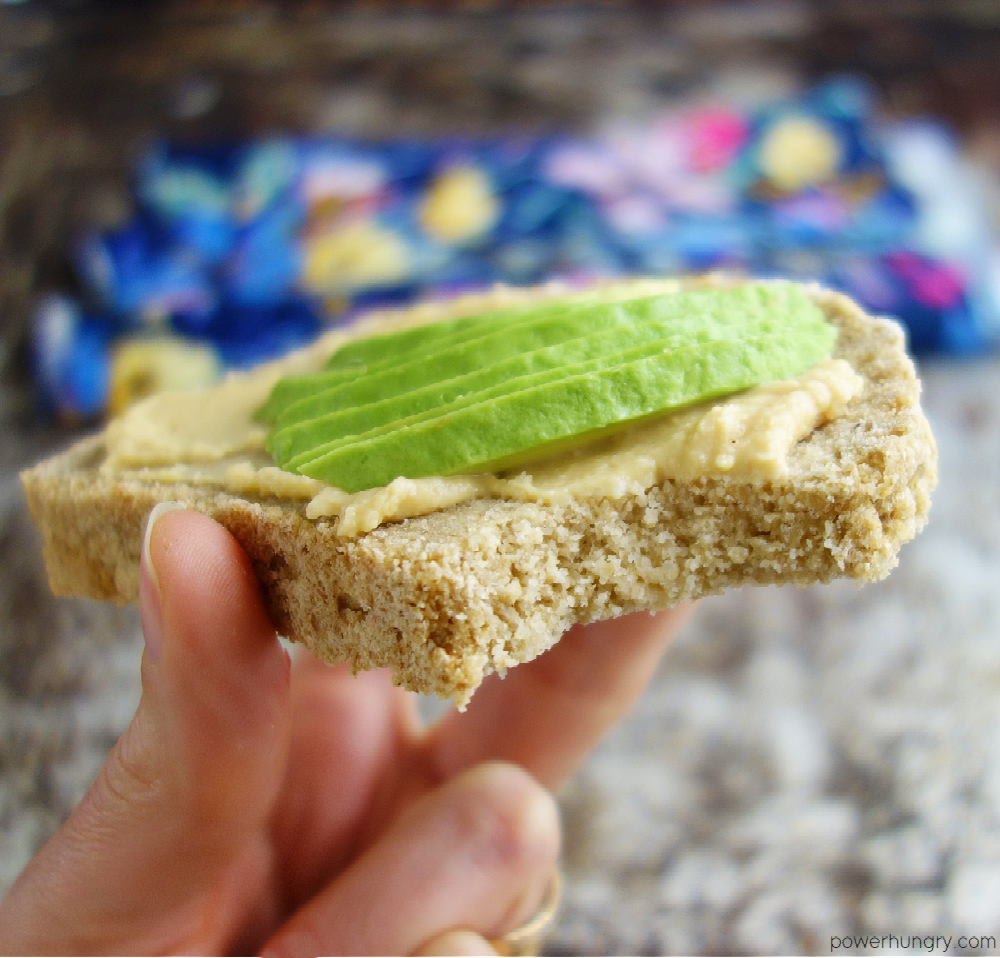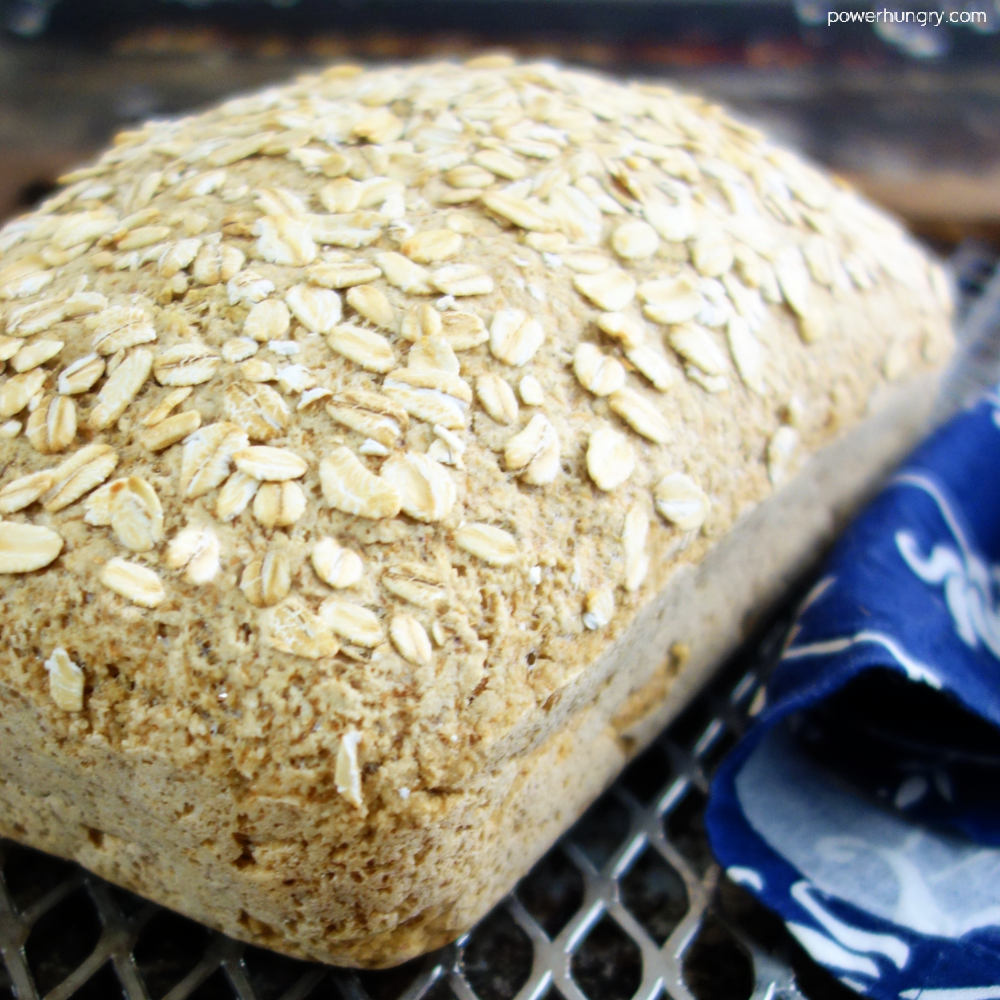Vegan gluten-free oat sandwich bread, made with ease! Hearty, delicious, and great with everything, it is also yeast-free and oil-free.
As promised in my Gluten-Free Buckwheat Sandwich Bread post the other week, I've been busy testing other combination of flours to create additional easy, vegan, gluten-free breads. My kitchen is very sticky.
But I would do it all over again. In fact, I am only just beginning, because the results are so exciting and delicious. First up, an oat loaf (because I <heart> oats). I attempted two all-oat loaves. The results were sunken and squidgy. So, I played with oat flour & brown rice flour combinations (the latter yields a finer texture, eliminates the oat squidge) until I got it right. This is it: Vegan Gluten-Free Oat Sandwich Bread.
As the name makes clear, it is sandwich bread, suitable for slicing thick or thick. But I could also have dubbed it "toasting bread," because it is positively outstanding when toasted and topped with sweet or savory spreads and toppings.
Recipe Benefits
If the mild, toasty flavor of oats sounds like the perfect sandwich bread to you, prepare to be wowed by all of the other features of this hearty, wholesome, totally toast-worthy bread. It is:
- Gluten-free
- Vegan (egg-free & dairy-free}
- Yeast-free
- Xanthan gum-free
- Oil-free
- Nut-free
- High in fiber (3.3 g per slice)
- Easy
Ingredients for the Bread
Like my Buckwheat Sandwich Bread, I've kept the ingredients for this loaf to a minimum. Here is what you will need:
- Rolled oats, ground into a flour (or use pre-ground oat flour)
- Brown rice flour (see my tip at the end for grinding your own, with ease)
- Whole psyllium husks (not psyllium powder)
- Baking powder
- Baking soda
- Salt (always optional/adjustable)
- Water
- Vinegar
- Optional: A bit of coconut sugar (or other sweetener)
I sprinkled some additional rolled oats on top, for decoration, but it is your choice to add them or not.
I like to add a tablespoon of coconut sugar to the recipe, but it is not necessary for bread's success. Adding a tablespoon of coconut sugar (or the sweetener of your choice) does not make the bread sweet. It does, however, enhance the oat-y flavor of the bread. It's one of those something-something ingredients, a subtle enhancement that heightens other flavors. It's up to you whether you want to add it in.
Step by Step Instructions
Making this bread is a cinch. The preparation (under 10 minutes), is quick, too.
Let's do this, shall we?
Step One: Combine the Wet Ingredients and Psyllium.
Whisk the water, vinegar, psyllium husk, and (opotional) coconut sugar in a medium mixing bowl. Let the mixture stand for about 5 minutes to thicken into a gel. This psyllium mixture provides body, volume and structure to the bread, much like eggs in traditional quick bread recipes.
Step Two: Mix the Dry Ingredients.
While the psyllium mixture is gelling, whisk the oat flour, brown rice flour, baking powder, baking soda, and salt in a large mixing bowl until blended.
Step Three: Mix to Make a Dough.
Add the psyllium mixture to the flour mixture and stir with a wooden spoon to combine. If you have made, or at least looked over, my Buckwheat Flour Sandwich Bread, you will note that this bread does not require "squishing" (i.e., using your hands to combine the wet and dry ingredients). While still quite thick, the dough can be combined by stirring with a spoon or spatula.
If you love to get your hands in dough (count me in), you are welcome to use your hands instead of a spoon!
Gather the dough, while still in the bowl, into a ball-shape.
Step Four: Shape the Dough.
Rinse your hands with water (it is a sticky dough; it is easier to shape it with moist hands). Shape the dough ball into a loaf shape to fit a 9x5-inch (22.5 x 12.5 cm) loaf pan. Place the loaf in the pan (which has been sprayed or greased). Smooth the top with your hands and press into shape, rounding the corners and sides.
If you choose, sprinkle the surface of the unbaked loaf with the some rolled oats.
Step Five: Bake the Bread.
Bake the bread in a preheated 325F (160C) oven for 90 minutes until risen, and the surface of the bread appears pale golden brown, dry, and crusty. The bread will also sound hollow when tapped.
Let the bread cool, in the pan, on a cooling rack for 15 minutes.
After the 15 minutes, remove the bread from the pan and cool completely on a cooling rack. Pretty, pretty, pretty!
Cool Completely Before Slicing
Make sure that the bread is completely cooled before slicing it. The reason? The oats. While the bread is still warm, the oats will stick (somewhat) to the cutting knife. Once cooled, the bread will have a fine texture that slices without any significant sticking.
What is the Texture & Taste?
First, texture: This loaf is fine-textured but hearty. It is closer to a dense whole wheat/whole grain loaf than a fluffy, white flour loaf. That also means that it is very filling. It can be sliced thin or thick As I mentioned earlier, it is especially good toasted.
I do not find this bread to be at all gummy in texture. Any subtle springiness is due to the high proportion of oats in the dough. When toasted, the bread is crispy and crunchy, with a warm, nutty flavor.
Taste: The flavor of the bread is very mild (both brown rice and oats hare neutral flavors). For a deep, robust flavor, consider adding up to 2 tablespoons of dark molasses to the dough. The bread is wonderful with just about any sweet or savory filling or topping you love.
FAQ
Can I use different flours (in place of the oat flour and brown rice flour)?
I do not recommend it. The proportion of wet and dry ingredients, as well as the quantity of psyllium husk, is particular to this oat flour and brown rice flour combination. The one exception is quinoa flour, which generally works well as a substitute for brown rice flour. I am working on other flour combinations and will continue to share the successes.
Can I Use Something Other than Whole Psyllium Husks?
No, it must be whole psyllium husks. Other gelling agents, such as flaxseed meal or chia seeds, will not work as direct substitutes (they might work, but it would involve some experimenting to determine their efficacy).
I also do not recommend psyllium powder. It can work as a substitute for the whole husks in some recipes, but not with this bread.
Can I Use Something Other than Vinegar?
Yes, an equal amount of lemon juice or lime juice can be used in place of the vinegar. Also note that any variety of vinegar (e.g., apple cider, white, balsamic, etc.,) can be used in the recipe.
Tip: Grind Your Own Oat Flour & Brown Rice Flour
I grind my own oat flour and brown rice flour. Whole brown rice and oats cost far less than ready-to-use rice and oat flours. And, it is fast (under a minute) and easy to do.
Rolled oats can be finely ground in a food processor or high-speed blender. Brown rice can only be ground in a high speed blender (regular blenders and food processors cannot grind the rice into a fine flour). Extra flour (oat or rice) can be store in an airtight container at cool room temperature for up to 3 months, or in the freezer for up to 1 year.
Happy Baking!
More Gluten-Free, Vegan Oat Breads to Try:
- Flourless Millet Oat Bread {vegan, GF, 5 ingredients}
- Rustic Irish Oat Scone Bread {Vegan, Gluten-Free}
- Oat Flax Skillet Bread {3-ingredients, Vegan, Oil-Free, GF}
- Oat, Seed and Nut Bread Minis {vegan, flourless, gluten-free}
- Healthy Zucchini Oat Bread {Oil-Free, Gluten-Free, Vegan}
- Gluten-Free Teff & Oat Bread {Vegan, Yeast-Free}
[tasty-recipe id="22365"]












0 comments